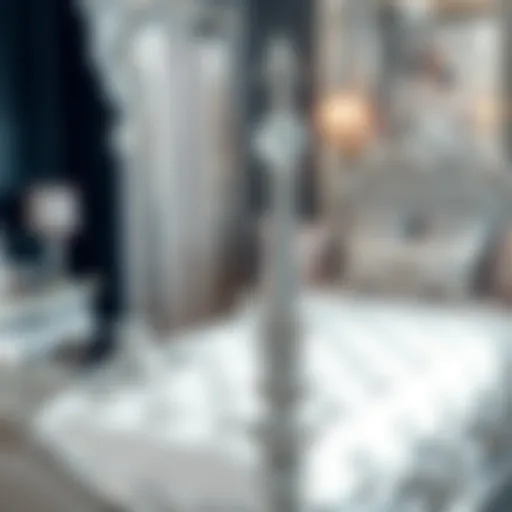Bathroom Color Decor Ideas for a Stylish Retreat
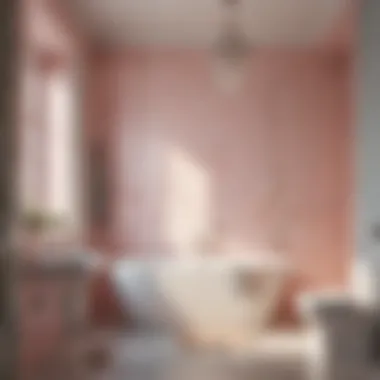
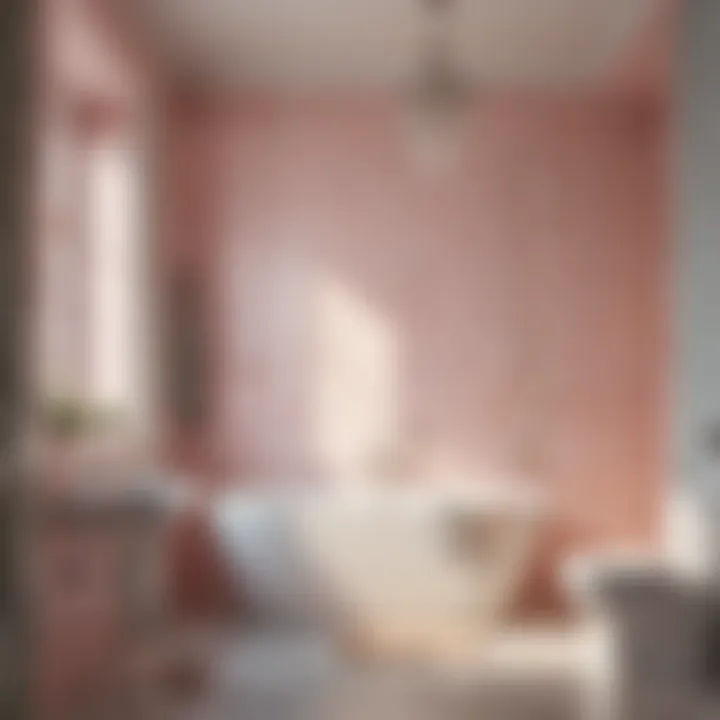
Intro
Creating a bathroom that feels peaceful and stylish goes beyond just picking any paint color. It involves understanding how colors interact with space, light, and emotions. This section sets the stage for what lies ahead—discovering how to effectively navigate the world of bathroom color decor. By understanding the essence of color psychology and practical application, homeowners can equip themselves with the knowledge to redesign their bathrooms into serene havens that reflect individuality.
In the following sections, we will explore current trends, dissect various color palettes, and analyze how these elements can come together harmony in your bathroom. Each idea presented encapsulates the spirit of comfort and elegance, ensuring your bathroom becomes an inviting space.
Trending Styles
Modern Minimalism
The modern minimalist approach emphasizes simplicity and functionality, stripping away the excess. In the bathroom, this can translate to clean lines, ample light, and a neutral color palette that fosters calmness. Think whites, soft grays, and light beiges that enhance the feeling of space. The charm of minimalism lies in its ability to create a visually uncluttered environment.
- Key Elements:
- Flat-panel cabinetry
- Simple fixtures with sleek designs
- Use of large tiles to create uninterrupted surfaces
- Natural light maximization through frosted or clear glass
Choosing a minimalist style not only means less visual clutter but can also ease the maintenance burden. An essential aspect of this look is integrating smart storage solutions to hide away toiletries and linens, effectively keeping the aesthetic polished.
Cozy Rustic
On the flip side, the cozy rustic vibe beckons with warmth and comfort. By utilizing earthy tones, reclaimed materials, and natural finishes, homeowners can achieve a relaxing hideaway reminiscent of a cozy cabin retreat.
- Key Features:
- Dark wood accents or reclaimed wood shelving
- Warm color palettes with terracotta, deep greens, or soft blues
- Vintage-style fixtures that invoke a sense of nostalgia
- Textured materials such as stone or terracotta tiles
Rustic decor often brings the outdoors in, facilitating a connection with nature. Adding plants, natural light sources, and textures makes the bathroom feel alive and cozy, likening it to a safe haven from daily stresses.
Color Palettes
Calming Neutrals
Neutral palettes play a pivotal role in creating a tranquil atmosphere. Shades like beige, taupe, and soft whites evoke a sense of peace. Their versatility lends itself to various design styles, making them a staple in bathroom design.
- Perfect for:
- Small spaces that need to feel larger
- Homes aiming for a consistent color scheme throughout
- Spaces designed for relaxation and unwinding
Incorporating calming neutrals allows for experimentation with textures and materials without overwhelming the senses. Accents can be introduced through towels, rugs, or decorative elements in muted tones to maintain tranquility.
Bold Accents
In contrast, using bold accent colors can inject energy and personality into a bathroom. Think rich navy blues, vibrant emerald greens, or even splashes of bright coral. These colors, when used thoughtfully, can create focal points that invigorate the overall design and provide visual interest.
- Ideas for Incorporation:
- Accent walls painted with a striking color
- Colorful tiles in a shower or backsplash
- Accessories like mirrors, towels, or art pieces in bold hues
Using bold accents doesn't mean overloading the space. It's about finding the fine line between exciting and overwhelming, creating a bathroom that feels alive yet remains soothing.
Understanding Color Psychology
Understanding how colors influence our perceptions and feelings is critical when decorating bathrooms. A well-thought-out color scheme can bring a sense of serenity to a space that often serves as a personal retreat. This part of the article lays the groundwork for why color choices go beyond mere aesthetics and touch on how they affect our daily lives.
Impact of Colors on Mood
Colors are more than just visual stimuli; they evoke emotions and set the tone for our experiences. For instance, soft blues and greens are known to inspire feelings of calm and relaxation. Imagine stepping into a powder room painted in a soft seafoam green; you might feel as if you've strolled along a tranquil beach.
On the other hand, vibrant hues like red or orange can evoke energy and warmth, but they might also be overwhelming if used excessively in a small bathroom. Consider a splash of coral on an accent wall alongside creamy whites or neutral browns to balance out that tenacity. Here are some specific impacts of colors:
- Blue: Promotes tranquility and peace.
- Yellow: Evokes warmth and cheerfulness but can be overstimulating in large doses.
- Green: Represents rejuvenation, linking to nature and growth.
The choice of colors should be aligned with the mood one wishes to create. A bathroom's purpose as a relaxation zone often underscores the need for soothing colors, which can lead to a refreshing start or end to the day.
Warm vs. Cool Tones
When thinking about a color palette, it is vital to distinguish between warm and cool tones. Each category can create vastly different atmospheres. Warm tones are often seen as comforting and energizing. These include colors like reds, oranges, and yellows. They bring a cozy sensation, reminiscent of sunlight—perfect for those seeking an inviting vibe in their bathrooms.
In contrast, cool tones—such as blues, greens, and violets—bring a feeling of calmness and spaciousness. They can make a small bathroom feel larger while offering a serene atmosphere. A few examples to consider:
- Warm Tones
- Cool Tones
- Ideal for traditional or rustic themes.
- Often paired with warm wood tones for a cohesive look.
- Excellent for minimalist or modern styles.
- Pairs beautifully with sleek, metallic fixtures.
Ultimately, the best approach is to think about the balance of these tones in relation to other decor elements. By doing so, one can create a harmonious bathroom that not only reflects personal style but also meets functional needs.
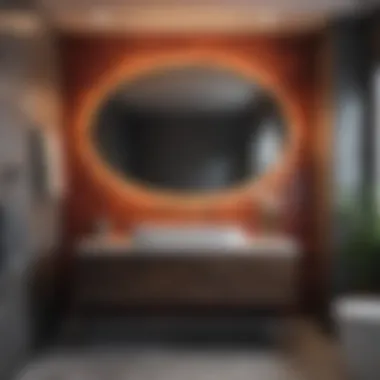
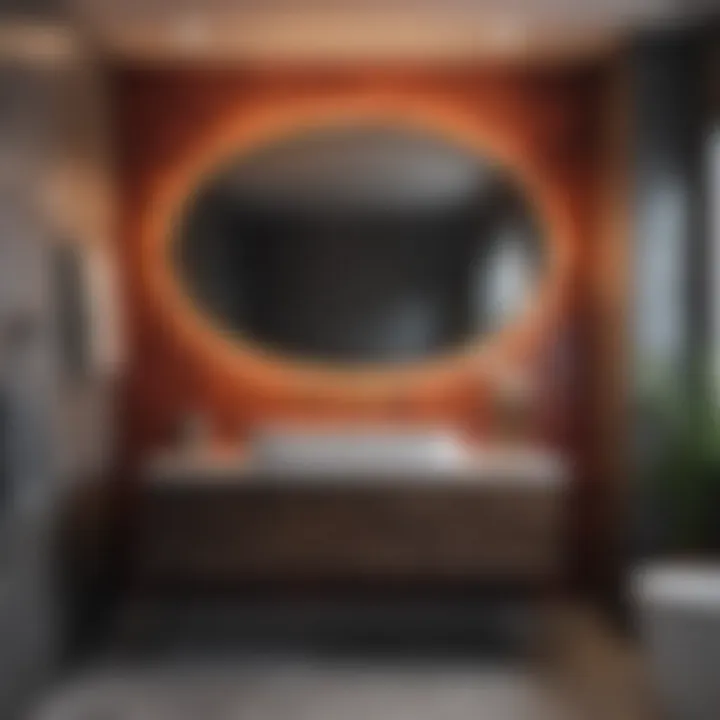
Selecting the Right Color Palette
When it comes to giving a bathroom a fresh, inviting atmosphere, selecting the right color palette can make all the difference. It’s not just about slapping on a coat of paint; it’s about creating a space that resonates with comfort and personal style. In bathrooms, more than any other room, the color scheme plays a pivotal role because it can enhance or diminish the feelings of relaxation. A well-chosen palette can transform a cramped space into a serene oasis, allowing homeowners to unwind after a long day.
Taking several factors into account is crucial when selecting a color palette. First, consider the usage of the space beyond hygiene. Is this bathroom a bustling family hub or more of a calm retreat? By identifying the primary function, you can better choose colors that will serve the needs of those who use the space regularly.
Another important consideration is the size and natural light availability. Lighter colors often help in making a small room feel larger and brighter, while darker shades can create a sense of intimacy and warmth, albeit at the cost of making the space seem smaller. Utilizing color strategically can optimize the bathroom experience, reflecting the intended ambiance and functionality.
Here’s why selecting a color palette matters:
- Creates a cohesive look: A well-designed color scheme ties together all the elements in the bathroom, from tiles to fixtures.
- Influences perception: Colors affect how we feel. Warm tones evoke energy, while cooler tones often promote calm and clarity.
- Enhances resale value: An appealing color palette can make your bathroom more attractive to potential buyers.
Analyzing Existing Elements
Before diving into the palette selection, it’s essential to analyze existing elements in the bathroom. This includes cabinetry, countertops, tiles, and fixtures. Each item provides hints about what colors might complement or clash with the overall aesthetic.
Taking stock of these features can guide color decisions. For instance, if the bathroom boasts beautiful dark wood cabinets, a lighter wall tone would not only contrast beautifully but also highlight the richness of the wood. On the other hand, if the countertops are white marble with gray veining, incorporating a soft green or blue can harmonize the elements, evoking a natural scene reminiscent of tranquil water bodies. By ensuring that all components work in unison, it creates a balanced and inviting atmosphere.
Color Harmonies and Comparisons
Engaging in color harmonies and comparisons is another vital step in evaluating color choices. Different color relationships can spark interest in the design and generate a compelling visual narrative. Here are some systems of color harmonies that can guide this process:
- Complementary Colors: These colors are located opposite each other on the color wheel, like blue and orange. They create an energetic contrast and can be beneficial for smaller accents in a larger neutral space.
- Analogous Colors: Found next to each other on the color wheel, these colors share two hues in common. For example, light green, green, and yellow-green work well for a soft, monochromatic look.
- Triadic Colors: This approach uses three colors that are evenly spaced around the color wheel, creating a vibrant yet balanced result when applied correctly.
It's also important to compare samples in the actual bathroom light. Colors can appear different throughout the day because of natural light, altering how you perceive their saturation and shade. Go for samples that reflect the varied times of day and ensure you visualize how they blend with the existing elements.
Remember, color can set the tone and complete the bathroom experience. Whether you lean toward calming neutrals or bold statements, knowing your existing elements and exploring color harmonies will help craft a space that feels just right.
In essence, selecting the right palette isn’t merely about aesthetic preferences or trends; it’s about creating a personalized sanctuary that serves its occupants effectively. When done right, the bathroom can merge beauty and functionality into a cohesive retreat.
Popular Bathroom Color Styles
Choosing the right color style for a bathroom can make or break the overall look and feel of the space. It’s important to understand that the bathroom is not merely a functional area; it can also be an oasis of calm and style. The right color palette can transform a mundane routine into a spa-like experience. With various color styles available, it’s crucial to consider the emotional and aesthetic impact of each option.
With this in mind, let's explore three prominent styles that have gained popularity in bathroom decor:
Monochromatic Schemes
Monochromatic color schemes involve using variations of a single hue. This approach can create a sleek, cohesive look, making the space feel more unified. Imagine a bathroom where every surface—walls, fixtures, and even accessories—plays into shades of blue. Light sky hues paired with deeper navy can evoke a sense of tranquility, reminiscent of a calm ocean.
One of the primary benefits of this scheme is that it simplifies selection. When dealing with a single color, the choices become more about which tones to incorporate rather than a complicated mix of hues. This can be especially appealing for housewives who may seek to create a serene environment without becoming overwhelmed by options. Additionally, monochromatic designs can create an illusion of space, making smaller bathrooms appear larger and more inviting.
Contrasting Combinations
Contrasting combinations offer a dynamic approach to bathroom decor. By juxtaposing two or more colors that are quite different, you can create visual interest and energy in the space. A striking example is a bright yellow paired with deep charcoal gray. This pairing brightens the mood while adding depth and dimension.
When employing contrasting colors, it’s important to maintain balance. Too much contrast can be jarring, so focusing on one dominant color with accents can yield a pleasing result. Consider using bold colors for accessories or wall art while keeping larger surfaces in a more neutral tone. This creates a focal point that draws the eye while allowing the space to remain harmonious. Homeowners looking to make a statement may find contrasting combinations appealing, as they can reflect individual personalities more vividly.
Neutral Tones and Their Appeal
Neutral tones have long been favored in bathroom designs, and for good reason. Shades like taupe, beige, and soft grays provide a calming backdrop and create a sense of understated elegance. These colors can easily adapt to changing trends, making them a smart choice for homeowners wishing to keep their spaces relevant over the years.
Moreover, neutral tones allow for versatility in accessories and decor elements. Whether you want to introduce bold colors for a seasonal refresh or keep things minimalistic, neutrals serve as the perfect canvas.
- Advantages of Neutral Tones:
- Timeless appeal that withstands trends
- Easy to pair with various colors and materials
- Promotes relaxation, ideal for a personal retreat
In summary, understanding popular color styles can significantly impact the bathroom’s atmosphere. Each approach has distinct benefits that cater to different preferences and lifestyles. By weighing the visual and emotional impressions they create, homeowners can craft spaces that not only look impressive but also feel like sanctuaries.
Harmonizing with Fixtures and Fittings
In any bathroom design, fixtures and fittings serve as the backbone. Whether it’s the faucet design, cabinet handles, or showerheads, these elements dictate the overall style. As we delve into harmonizing color with these features, it’s essential to understand how they blend into the larger narrative of the room. The right balance enhances visual appeal and creates a polished look.
When selecting colors for your bathroom, thinking of your fixtures as focal points, rather than just functional parts, is key. Color should not clash but instead complement these elements, creating a sense of cohesion and unity. For instance, if you have bronze faucets, integrating colors with warm undertones can amplify the richness of the metal. This attention to detail is what can elevate a standard bathroom into one that feels thoughtfully curated.
Benefits of Harmonizing Colors with Fixtures:
- Creates Flow: Ensures everything feels interconnected, making for a seamless appearance.
- Enhances Functionality: Good color choices can highlight features and make the space feel larger or cozier, depending on your goals.
- Increases Aesthetic Value: When colors align with fixtures, it transforms the bathroom into a visually appealing retreat.
- Reflects Personal Style: Thoughtful color harmony allows individual taste to shine through.
As homeowners begin this exploring journey, a clear consideration of these aspects will provide clarity in color selection.
Balancing Colors with Vanity Cabinets
Vanity cabinets often occupy a significant amount of visual space in a bathroom. Their color should harmonize well with the overall decor yet have its own character. Think about what the cabinet needs to convey. For example, a bold blue cabinet can make a statement against neutral walls, while a white cabinet can lend itself to a more airy and spacious feel in smaller bathrooms.
When selecting the cabinet color, assess the existing color palette:
- If you have warm colors on your wall, consider a cabinet in a matching warm tone.
- For cooler wall colors, a soft grey or muted blue may be more fitting.
- Don't shy away from mixing textures too. A matte finish offers a sultry look, while a glossy finish adds depth and shine.
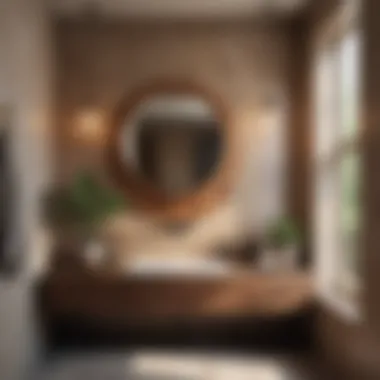
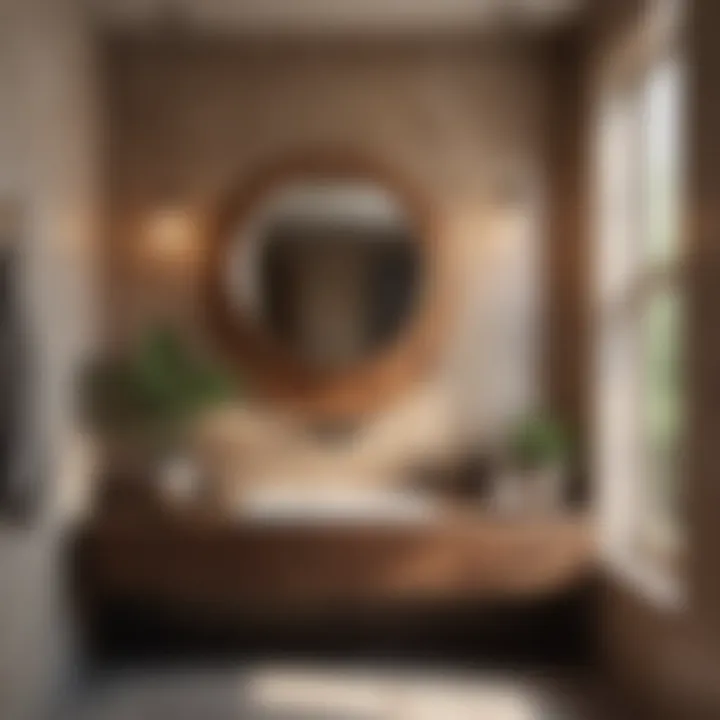
Finding that sweet spot might mean testing paint samples on the actual cabinet or using large swatches. Always take the time to observe how light interacts with the colors throughout the day.
Integrating Tiles and Grout Colors
Tiles and grout colors play a pivotal role in the overall look of a bathroom. Grout can make or break a tiling job, so it’s vital to select it with care. Vivid grout against neutral tiles can add a splash of personality and amplify a contemporary design, while matching grout creates a seamless, clean visual that can make smaller spaces feel expansive.
When integrating tiles with color decor, here are some tips:
- Consider Contrast: Light tiles with dark grout offer striking visual tension and keep maintenance in mind since darker grout hides stains better.
- Utilize Patterns: If you’re adventurous, patterned tiles can become the stars of the show while keeping the grout subtle.
- Mind the Finish: Glossy tiles can reflect light, adding brightness and depth, while matte finishes might convey a more relaxed vibe.
Ultimately, the interplay of tiles and grout color can breathe life into your design, making your bathroom inviting and extending the decor theme throughout the space.
"Color is a power which directly influences the soul." - Wassily Kandinsky
In summary, harmonizing color with fixtures, vanity cabinets, and tiles is not just an aesthetic choice. It’s an opportunity to craft a bathroom that resonates with personal style and invites comfort, transforming it from a simple utility space into a serene oasis.
Accent Colors in Bathroom Design
Accent colors play an essential role in bathroom design. They serve as the spice that elevates a well-planned decor scheme into something striking and visually stimulating. Accent colors can change the perception of the space entirely, creating a rich atmosphere without overwhelming the senses.
When considering accent colors, the main goal is to enhance the primary colors of the bathroom. They can provide contrast, highlight certain features, or even offer a pop of vibrancy against neutral tones. Using just a touch of color in key areas allows homeowners to personalize their spaces while keeping the overall aesthetic cohesive and thoughtfully arranged.
Furthermore, the strategic use of accent colors can influence how a small room appears. It can make walls look taller or wider, channeling visual interest away from clutter and focusing attention where it matters most. Whether choosing a warm or a cool tone for the accents, the care taken in this choice can significantly impact the overall feel of the bathroom.
Choosing Accent Walls
An accent wall is often seen as a bold move in interior design, especially in a bathroom setting. It's an opportunity to create a focal point without committing to an entire room overhaul. Consider, for example, a stunning deep navy blue wall behind the vanity or a textured wallpaper that adds depth. This can draw the eye and serve as a conversation starter.
When selecting wall colors, homeowners should keep in mind the hues prevalent in the remaining space. A contrasting yet complementary color can unify the room while making the accent wall stand out. The use of matte or gloss finishes can also impact lighting and perception; for instance, a glossy wall can make colors pop, capturing the light in a captivating way.
Moreover, remember the size of your bathroom. A small, dimly lit space may benefit from lighter accent colors to keep the room feeling airy. Alternatively, large bathrooms can pull off darker shades that create an atmosphere of luxury.
Here are a few considerations when choosing an accent wall:
- Location Matters: Select the wall that naturally draws attention, like the one directly behind the sink or tub.
- Texture: Think about using different materials such as tiles or wood to create a textural contrast.
- Ceiling Height: Higher walls can handle bolder colors or patterns without feeling cramped.
Utilizing Accents with Accessories
Incorporating accent colors through accessories is an effective way to enhance and complement your bathroom design without extraordinary effort or expense. Accessories such as towels, soap dispensers, and bath mats are perfect for this, allowing easy updates that can adapt with changing tastes or trends.
- Textiles: Opting for colored towels or a patterned shower curtain can introduce vibrancy without needing a major redesign. Choose shades that resonate with your established palette.
- Functional Elements: Consider colorful storage baskets or unique light fixtures. These elements not only serve a practical purpose but also double as decorative pieces.
- Art and Decor: Wall art can further echo the accent colors. A colorful piece can tie together the elements in your bathroom, creating a harmonious feel.
"Accentuating your space doesn’t have to mean a whole new paint job; it can be as simple as switching out a few key pieces."
By using these tactics, your bathroom can become a canvas that reflects personal style, making the space distinctly yours while maintaining sophistication.
Textures and Materials
When it comes to personalizing a bathroom, textures and materials play a critical role in shaping the overall aesthetic and comfort of the space. While colors set the mood, the choice of materials and textures enhances what you have in mind for a serene retreat. Consideration of these elements not only provides a visual narrative but also introduces tactile experiences that elevate the design. Understanding how textures harmonize with colors can create a bathroom that draws you in, almost as if it's a special haven where stress melts away.
The right textures lend depth to your color selections. For example, smooth tiles can contrast beautifully with rough wood finishes or soft rugs, cultivating a rich experience for anyone entering the space. This duality aids in breaking the monotony, allowing for a mix that can appeal to varied design tastes. Furthermore, textures influence perceptions of hygiene; shiny surfaces often feel cleaner, whereas textured ones can feel warmer and more welcoming. Ultimately, selecting appropriate materials and textures should align with both the utility and beauty one seeks in a bathroom environment.
Incorporating Natural Elements
Natural elements often breathe life into spaces, shifting the atmosphere to one that feels more organic. Think of how stone, wood, or plants can transform the vibe of a bathroom. Integrating materials like teak wood for cabinets or river stones for flooring taps into the calming essence of nature.
- Natural Stone: Limestone or slate can introduce an earthy tone, giving off a grounded feel that will help you unwind after a long day.
- Wood Finishes: Whether through cabinetry or accessories, wood introduces warmth. Its organic texture makes the space feel less sterile and more lived-in.
- Greenery: Introducing plants is another excellent idea. They not only provide a splash of color but also promote well-being. A simple fern or bamboo can work wonders.
One must keep in mind that while natural materials have aesthetic appeal, they also require proper care and maintenance. For example, wood can warp if exposed to excessive moisture, so it’s essential to use water-resistant finishes or sealants to protect it.
Selecting Suitable Textiles
Textiles contribute significantly to the comfort level of your bathroom. They include everything from towels to bath mats and curtains. Choosing the right fabrics can anchor your color scheme and bring the emotional atmosphere you desire.
Here are some choosing notes:
- Shower Curtains: Opt for curtains that have a good weight to them. Lighter materials may billow in the breeze of a running fan and can throw off the whole look. Consider something heavier in a color that complements your primary palette.
- Bath Mats: Plush, absorbent mats add a layer of coziness and warmth. Choose a color that enhances your color scheme, whether it be a bold statement or a neutral tone.
- Towels: The fabric used for towels impacts both the feel and practicality. Go for cotton or a cotton blend for softness. These can also serve as additional color accents that tie your whole look together.
"An inviting bathroom not only pleases the eye, it also comforts the soul. Consider your senses beyond just sight."
In sum, textures and materials aren't mere afterthoughts but foundational elements that can significantly influence how a bathroom looks and feels. When selected with care, they create an inviting atmosphere that aligns with the peaceful, serene characteristics sought in your personal retreat.
Lighting Considerations
Lighting plays a pivotal role in bathroom design. When thinking about color decor, many often overlook just how significant the right lighting can be in enhancing a space's overall feel. Not all lighting is created equal; the choice between natural and artificial light can completely transform how colors appear and influence the mood of your bathroom.
The main advantage of thoughtful lighting is its ability to highlight the best features of your color choices, whether that’s the soft hue of a freshly painted wall or the intricate patterns of a unique tile. Moreover, different lighting setups can create an atmosphere ranging from serene calm to energizing invigoration. It’s essential to aim for a harmonious balance that complements your chosen color palette while also considering practicality and function.
Natural Lighting's Influence
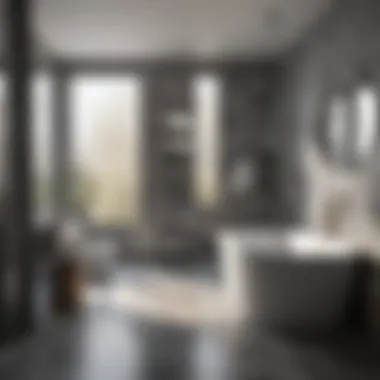
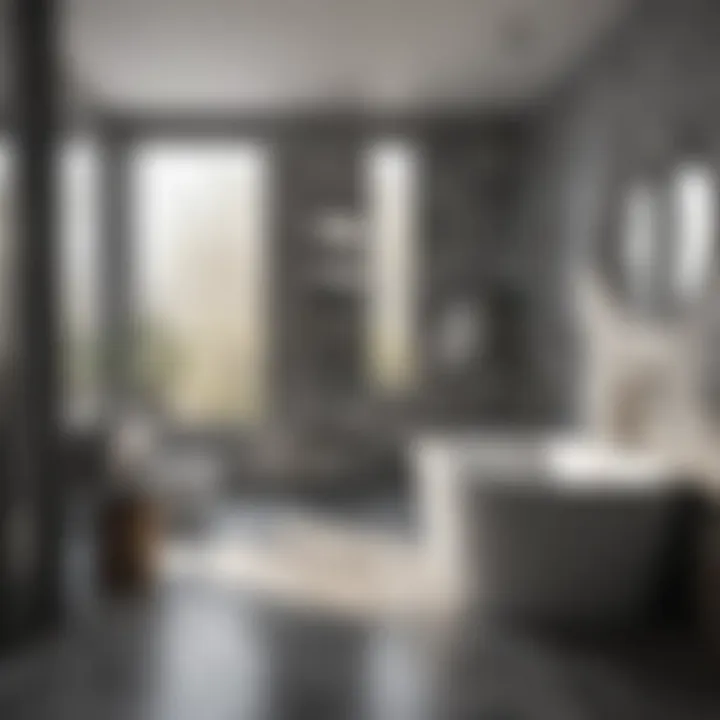
Natural light is the most flattering and, arguably, the most sought-after when designing a bathroom. Large windows or strategically placed skylights can fill the room with warm sunlight. When setting up your color scheme, consider the following:
- Time of Day: The intensity and tone of sunlight change throughout the day. Morning sunlight tends to be soft, while midday light can be harsh. Take note of when your bathroom receives the most light to see how colors look at different times.
- Color Adaptation: Colors can bounce off light in unexpected ways. For instance, a light blue wall may look different under morning lighting than it does at sunset. Experiment with your colors in natural light to understand how they perform.
- Mood Enhancement: The interaction of natural light and color can evoke feelings of warmth and tranquility. Soft greens or blues combined with abundant natural light can bring about a sense of peace, making your bathroom feel like a spa retreat.
Choosing Artificial Lighting Colors
If your bathroom lacks sufficient natural light, there’s no need to fret. Artificial lighting can also set the scene beautifully, but it requires a bit more thought. Here are some things to keep in mind:
- Type of Bulbs: The choice between incandescent, LED, or fluorescent can significantly impact the tone of your lighting. Incandescent bulbs provide a warm glow ideal for cozy environments, while bright, crisp LED lights can enhance clarity and vibrancy of colors.
- Color Temperature: Measured in Kelvin (K), the warmth or coolness of your lighting matters. Aim for bulbs that fall in the warm to neutral range of 2700K to 4000K. This range is generally flattering and can complement various color schemes.
- Layered Lighting: Don’t settle for one overhead light; incorporate a mix of wall sconces or vanity lights to create layers. Lighting from multiple angles adds dimension, reducing the starkness of shadows and allowing colors to showcase their true beauty.
"Good lighting is the most valuable accessory in a bathroom, it not only serves a function but enhances the entire design aesthetic."
In summary, understanding and leveraging lighting can tremendously affect your bathroom's ambiance. By choosing the right balance of natural and artificial lighting, you can create a space where your color decor truly shines.
Sustainable Color Choices
When it comes to revamping a bathroom, the shades you choose can significantly affect not only the aesthetic but also the environment. Sustainable color choices are essential as they incorporate practices that are gentle on both the planet and your health. The trend towards eco-conscious living means that more homeowners are looking to minimize their impact while still crafting beautiful spaces. This section discusses the benefits, considerations, and various aspects linked to selecting sustainable color options for bathroom decor.
Eco-Friendly Paints
Choosing eco-friendly paints is a fundamental step in ensuring the sustainability of your bathroom. These paints typically have low or zero volatile organic compounds (VOCs), which means they emit fewer harmful gases into the air. For instance, when you select a brand that prioritizes sustainability, you’re not just refreshing your walls; you’re also making a healthy choice for your family.
Some popular eco-friendly options include:
- Natural paint: This paint uses plant-derived ingredients and minerals instead of synthetic chemicals.
- Low-VOC paint: Although it may contain some chemicals, these are much lower in volume and typically not harmful when cured.
- Milk paint: An oldie but goodie, this option uses milk protein and mineral-based pigments, creating a non-toxic finish.
It’s essential to read labels when selecting any paint. A product labeled as "green" does not always mean it’s safe. Brands like Benjamin Moore's Natura or Sherwin-Williams’ Harmony are recognized for their environmentally friendly offerings. Selecting these paints not only contributes to a healthier indoor air quality but also aligns with eco-conscious practices, benefiting the planet and your personal wellness.
Sourcing Sustainable Materials
Once you’ve chosen your colors, understanding where to find sustainable materials is equally crucial. The sourcing of materials focuses on using items that have minimal negative impact on the environment. This can include tiles made from recycled materials or fixtures crafted from responsibly sourced woods that require less energy to produce.
Here are some key considerations for sourcing sustainable materials:
- Local sourcing: Whenever possible, buy materials produced locally to reduce shipping emissions. Plus, local artisans often focus on sustainable practices.
- Recycled materials: Look for tiles, countertops, or accessories made from recycled glass or reclaimed wood. These materials not only reduce waste but also add a unique touch to your decor.
- Certifications: Keep an eye out for materials that come with certifications like LEED (Leadership in Energy and Environmental Design) or FSC (Forest Stewardship Council). These certifications guarantee that the products meet specific environmental standards.
- Durability: Invest in high-quality, long-lasting materials. While the upfront cost may be higher, fewer replacements mean less waste in the long run.
Incorporating sustainable materials into your bathroom decor is about making thoughtful decisions. The impact goes beyond aesthetics; it resonates with an ethos of responsible living. Leveraging eco-friendly paints and sourcing sustainable materials not only creates a profound effect on your bathroom’s appearance but also champions a more responsible approach to decorating.
"Sustainability is not just a trend; it’s a commitment to future generations. Every conscious choice makes a difference.”
Case Studies: Transformative Bathroom Projects
In discussing bathroom decor, real-life transformations serve as powerful examples of how thoughtful color choices can elevate a space. Case studies not only illustrate the practical application of color psychology and design strategies but also highlight the profound impact of these considerations on overall wellness and aesthetic pleasure. Homeowners often seek inspiration from others' projects to incite their creative juices, making this section particularly relevant. Let’s dive into specific examples that showcase both minimalist approaches and bold innovations, capturing the essence of what can be achieved in bathroom design.
Minimalist Bathroom Makeover
When it comes to minimalism in bathroom design, simplicity is key. A minimalist bathroom makeover can refresh an outdated space without overwhelming the senses. This approach emphasizes clean lines, subtle colors, and functional decor. For instance, envision a bathroom where white dominates, accented by accents of soft gray and muted wood tones. This creates a tranquil environment that feels airy and open.
Consider the following elements in a minimalist bathroom makeover:
- Color Palette: Focus on whites, soft beiges, or pastels. These colors allow light to reflect easily, enhancing the brightness of the space.
- Materials: Use sleek surfaces like matte tiles or smooth stones to maintain an uncluttered look.
- Fixtures: Choose modern, simple fixtures that complement rather than distract from the space’s design.
An ideal case is the transformation of a cramped, dark dungeon-like bathroom into a bright and calming retreat through such an approach. The simple addition of frosted glass panels not only allows light to flow but also retains privacy, essential in a room dedicated to personal care.
"In design, less is often more. The less fuss in a bathroom, the more it invites relaxation and clean living."
Bold Decor Innovations
On the other end of the spectrum lies the world of bold decor innovations that breathe life into bathrooms seeking a transformative change. Here, color takes center stage. Think dramatic color combinations such as navy blue paired with vibrant yellow or deep emerald green contrasted with crisp white. These daring choices can invigorate a bathroom, inspiring a sense of creativity and personality.
Some strategies for implementing bold decor innovations include:
- Accent Walls: Choose one wall to be the focal point. A rich color or an exciting wallpaper design can give the room character without overwhelming all the elements.
- Artistic Touches: Implement unique and colorful fixtures or accessories, such as a striking sink or bold artwork. These small elements can make a big statement.
- Lighting Choices: Use creative lighting fixtures that not only provide illumination but also serve as conversational pieces, adding flair to the overall design.
A splendid example involves a client who embraced a tropical theme, painting the walls a deep teal while introducing lush palm motifs through accessories. The effect? A lively atmosphere that feels like a spa escaping simply by stepping through the bathroom door.
Finale: Personalizing Your Space
Personalizing your bathroom is akin to tailoring a perfectly fitted garment. It isn’t just about color choices; it's about crafting a sanctuary that mirrors your unique tastes and lifestyle. Every detail—from the shades on the walls to the accessories scattered across countertops—plays a role in creating a serene and inviting atmosphere.
Emphasizing Individual Style
In a world filled with trends that come and go like the tide, emphasizing individual style is crucial. The bathroom, an often overlooked space, provides an excellent canvas for self-expression.
There are numerous pathways to infuse personality into your space:
- Color Selection: Pick a color palette that resonates with you. Whether you gravitate towards deep blues, soft pastels, or warm earthy tones, your selected hues can evoke feelings of comfort and familiarity.
- Custom Fixtures: Consider unique taps or a vintage mirror. These pieces can serve as focal points, expressing personal flair while capturing the eye.
- Artwork and Decor: Adding artwork can dramatically shift the atmosphere. A beautifully framed picture or a quirky piece of wall art can turn a mundane bathroom into a display of personal creativity.
Think of how these elements align with your personality. A nature lover might incorporate green tones, while minimalists might prefer a crisp white backdrop. The heart of personalization lies in reflection—what brings you joy?
Future Trends in Bathroom Decor
Looking ahead, the world of bathroom decor evolves with each season, influenced by changing lifestyles and the desire for sustainability. Homeowners are becoming more aware of the trends that not only beautify their spaces but also contribute to eco-friendly living.
- Nature-Inspired Designs: Bringing the outdoors in through organic hues and natural materials continues to gain traction. Think of soft greens, sandy neutrals, and textures like rattan or cork—these evoke a sense of tranquility while being in tune with nature.
- Smart Technologies: Smart bathrooms are on the rise, with integrated lighting that adjusts based on the time of day and water-saving fixtures that are both stylish and functional. Homeowners who value technology will find these features appealing.
- Sustainable Materials: Eco-friendly choices are for sure here to stay. Homeowners are moving towards sustainable paint options and recycled materials. This not only reduces their carbon footprint but can also create a unique charm to your bathroom.
In sum, as creativity and sustainability converge, finding a balance that fits your individual style while remaining conscious of the environment is a pathway to a future-ready bathroom. Embracing these trends offers a chance to transform an ordinary bathroom into a retreat where every detail whispers your personal story.















